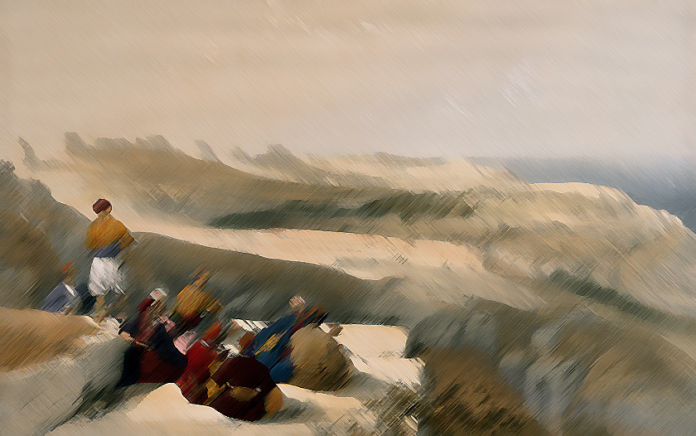Secular History
It’s always sort of fun and interesting to follow various people groups, like Israel for instance, throughout history.
When we look at the Mediterranean area through a modern day lens, it all looks so exotic and far away. It all probably wasn’t so glamorous back in 1200bc though.
There are plenty of reasons why various people groups move from one place to another. Famine, war, and disease can be attributed to the large historical movements of people — In ancient Greece, the start of the Iron Age was accompanied by a period of cultural decline.
Seems that men could make better war with iron than they could with bronze and as a result, during the period of making better war, large people groups began their shift or migration.
We all already know the story of Israel, so how about we tell the story of the Philistines.
Starting in the Aegean and the associated migration of the Philistines.
In about 1200bc the Mycenaean civilization began it’s collapse. The Mycenaeans were later pushed out or otherwise conquered and enslaved by the Dorians. Many of the Mycenaeans left to search out a new homeland.
The Philistines (as they were known as) originated as an immigrant group from the Aegean that settled in Canaan circa 1175bc — they gradually assimilated elements of the indigenous Semitic Levantine societies while preserving their own unique culture. Geological and DNA evidence supports this.
At sites occupied by the Philistines at an early period, a distinctive type of pottery and a variety of the 13th-century Mycenaean styles has been found. Philistine temples and shrines displaying a variety of Aegean design elements have been excavated in Ashdod, Ekron, and Tel Qasile.
There are some who might speculate that the Philistines were a part of the Minoan culture, but I’m doubtful of that because according to what I’ve researched, the Minoan’s didn’t build high walls or other fortifications around their cities, but the Mycenaean’s did, thus indicating that the Mycenaean’s may have been possibly more warlike. Also, it’s been proposed that the Minoan culture ultimately fell to the Mycenaean’s after a presumed Mycenaean invasion.
I’ll also speculate that the Mycenaeans were being displaced during this time period by the Dorians who had invaded from northern Greece.
Greek civilization as recognized today grew out of the aftermath of the Dorian invasion. (it’s been speculated that Mycenaen culture was kept alive through those Greeks who would eventually found Athens while Sparta proudly claimed Doric ancestry)
The first written records of the Philistines are inscriptions and reliefs in the mortuary temple of Ramses III at Madinat Habu: Egyptian sources name one of these implicated Sea Peoples as the pwrꜣsꜣtj, generally transliterated as either Peleset or Pulasti. Following the Sea Peoples’ defeat, Ramesses III allegedly relocated a number of the pwrꜣsꜣtj to southern Canaan.
It might be important to note that these Sea People (Peleset or Pulasti) may have been refugees in a sense, because behind the very large military arm of the group were boats filled with women, children, and livestock.
Ramses III probably made a note of the women, children, and livestock after defeating the Peleset or Pulasti army and allowed for their relocation to an area that Egypt already very sparcely controlled.
Upon their arrival in southern Canaan, the Philistines proceeded to annihilate the Avvite people who had lived in the region of ‘Azza (Gaza), and settled in place of them.
As an added note: Around the year 1850 BCE, several centuries before the arrival of the Philistines, the Avvite-Canaanites at Ashqelon built what is believed to be the oldest arched gateway in the world.
It might also be noted that due to the amount of trade in the region, there was also a Minoan presence in biblical Gerar during the age of the Patriarchs. Minoans hailed from Crete, so it may not be too surprising that they would be categorized as Kaftorim or Pelishti’im (Philistines) in the collective memory of the region.
The particular area of southern Canaan where the Philistines settled included the coastal plain of Palestine from Joppa (modern Tel Aviv–Yafo) southward to Gaza. The area contained the five cities (the Pentapolis) of the Philistine confederacy (Gaza, Ashkelon, Ashdod, Gath, and Ekron) and was known as Philistia, or the Land of the Philistines. It was from this designation that the whole of the country was later called Palestine by the Greeks.
As an aside:
“The English term Philistine comes from Old French Philistin; from Classical Latin Philistinus; from Late Greek Philistinoi; ultimately from Hebrew Pəlištī (פְּלִשְׁתִּי; plural Pəlištīm, פְּלִשְׁתִּים), meaning ‘people of Pəlešeṯ (פְּלֶשֶׁת)’; and there are cognates in Akkadian Palastu and Egyptian Palusata; the term Palestine has the same derivation.” – Wikipedia
The political structure of Philistine society wasn’t really unique for it’s time. There was no unified Philistine nation-state or even a Philistine kingdom to speak of; the Philistine people were somewhat unified by a confederacy of the five leading cities: Ashdod, Gath, Ashkelon, Ekron, and Gaza.
The individual chieftains set the agenda in their cities, but when it came time for war, they all met to make a group decision.
Israel was pretty much set up the same way — Upon settlement in Canaan, the Israelites ruled through a tribal confederation.
The primary reason why the Philistines and Israelites were enemies was due to both peoples desiring to put the Levant under their political hegemony.
Here we pretty much had loose confederations of city states trying to control an entire land.
It was pretty hard for both to succeed in the total rule of the land without having some sort of centralized government structure in place.
The wars between the Philistines and the Israelites went on for a while — both sides were eventually defeated when the mighty Assyrian Empire overwhelmed the entire Levant and made them both vassals.
This whole business in the Levant between Israel and the Palestinians has been going on since the beginning of the iron age (at least) — Here we have two people groups going after each other for control of the land.
The Philistines replaced the Avvites when they came over from the Aegean and Israel replaced the Canaanites when they came up from Egypt. Both people groups escaped slavery and brought all of their women, children, and livestock with them — Both people groups wanted land and both people groups were prepared to fight for that land. The parallels as to how they governed are striking as well. Both people groups are different but the same.
When you stop to consider the actual history of the region involved here, what with the migration of these two people groups (Israel and the Philistines) and all of what’s gone on over the centuries between them, this whole business of “free this” or “free that” all sort of comes off as being just a bit disingenuous.
The only times there has been really any so-called peace in the region is when the big kids on the block (Britain, Egypt, Assyria, Rome) go in and provide some semblance of order. What’s going on now in the Levant is somewhat akin to two 3rd graders that hate each other being left alone on the playground unsupervised.
sourced:
The Arrival of the Philistines
The Aegean
Minoan civilization
Philistine people
DNA reveals European roots of the ancient Philistines






